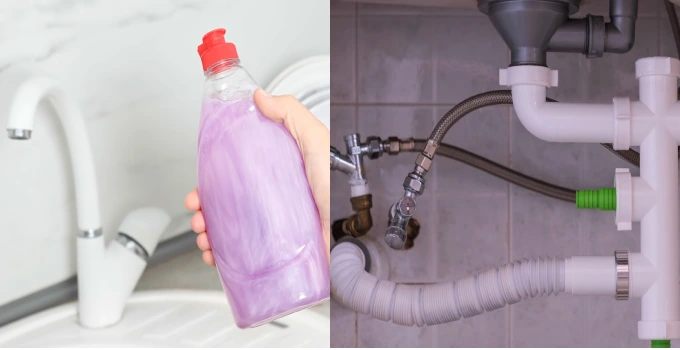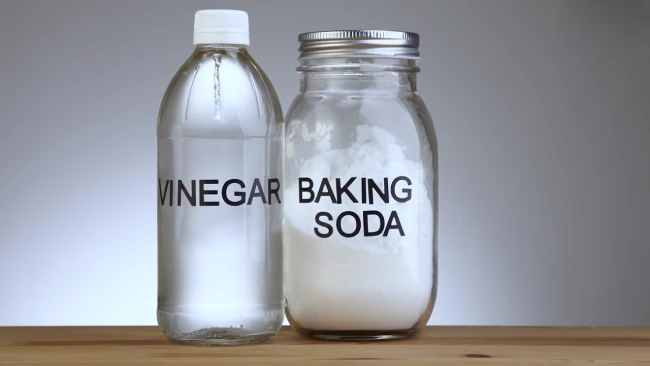Last Updated on July 31, 2023
Clogged drains can quickly become a homeowner’s worst nightmare, causing inconvenience and potentially damaging the plumbing system.
Grabbing any solution within reach is tempting when you encounter a stubborn blockage, even if it means resorting to unconventional methods. One such questionable approach often comes to mind is using toilet bowl cleaner to unclog a drain.
Toilet bowl cleaner is not specifically designed to unclog drains. Using it for that purpose is not recommended.
While some toilet bowl cleaners may contain chemicals that can dissolve or break down organic matter, they are not formulated to clear clogs in drains effectively.
If you have a clogged drain, using a product specifically designed for that purpose is better. Now let’s talk about some effective methods for unclogging a drain.
What Should You Do to Unclog a Drain?

When you face a clogged drain, several methods can be used to clear the blockage effectively.
Listed below are a few quick overviews of each method:
Method #2: Baking Soda and Vinegar
Method #3: Chemical Drain Cleaner (Use with caution)
Let’s examine each method in detail.
Method #1: Plunger
The Plunger Method is a simple yet effective way to unclog a drain, and it can be used on both sinks and bathtubs. Here’s how to do it.
Step 1: Fill the Sink or Bathtub
Before using a plunger, ensure that there’s enough water in the sink or bathtub to cover the rubber cup. The water creates a seal around the plunger and increases its suction power, making it easier to remove the clog.
You need to avoid overflowing the basin while adding water. Fill the container appropriately for best results.
Step 2: Position the Plunger
Position the plunger over the drain once the sink or bathtub has enough water. It ensures the rubber cup creates a tight seal around the surface surrounding the drain.
A firm, tight seal establishes the suction power necessary to dislodge the clog. Also, ensuring that no air escapes during the plunging process is vital, as this can weaken the suction pressure and hinder the plunger’s effectiveness.
Step 3: Apply Pressure and Suction
After positioning the plunger correctly, apply vigorous pumping movements to create suction and pressure around the clog. Use firm rhythmic motions, as they create a solid and stable suction that can effectively dislodge the clog.
The key is to apply controlled and forceful pressure rather than random or erratic movements. It also prevents the clog from becoming more firmly lodged in the drain.
Step 4: Repeat the Plunging
Repeat the plunging process several times after successfully using the plunger to dislodge the clog. This will ensure a strong seal is maintained and force continues to be applied.
It breaks up the clog and lets it move through the pipes. You’ll need to continue plunging until water flows freely through the drain to ensure the clog is cleared fully.
Step 5: Test the Drainage
To finish, check the drain’s flow to confirm the water drains freely. If the water drains, run hot water for a minute to flush out any remaining debris.
Method 2: Baking Soda and Vinegar

Baking Soda and Vinegar is an effective way to clear standing water in a clogged drain. To use this method, follow these steps:
Step 1: Clear Standing Water
Clear any standing water in the bathtub or sink before you begin unclogging the drain with baking soda and vinegar. To clear standing water, use a bucket or a small container to scoop as much water out of the sink or bathtub as possible.
Step 2: Pour Baking Soda and Add Vinegar
Once you have cleared the standing water, add the baking soda and vinegar mixture to the drain. Pour approximately one-half cup of baking soda down the drain, making sure to reach as far down as possible.
After that, throw 1/2 cup of white vinegar in the drain. Combining baking soda and vinegar creates a fizzing reaction that helps break down the clog.
Step 3: Allow Time
After you pour vinegar and baking soda down the drain, let it sit for 15-30 minutes. During this time, the chemical reaction helps dissolve the clog by breaking down the organic matter causing the blockage.
The length of time you wait will depend on the severity of the clog. You can wait for as little as 15 minutes for a mild clog. You might have to wait up to 30 minutes for a more severe clog.
Step 4: Flush with Hot Water
It is time to flush the drain with hot water to remove the clog and any remaining debris. This will help wash away any remaining organic material, including grease and soap scum, that may be present in the drain.
The hot water will also help dissolve any leftover baking soda and vinegar in the drain. Ensure the water is as hot as possible to aid in flushing. You may need to repeat this step a few times to ensure the drain is fully cleared.
Method 3: Chemical Drain Cleaner (Use with caution)

To unclog a drain, let’s use chemical drain cleaners. Just follow these steps:
Step 1: Read and Follow the Instructions
To unclog a drain with a chemical drain cleaner, read the instructions on the bottle and follow them carefully. This is because different products may have specific usage guidelines that must be adhered to clear the blockage effectively.
Step 2: Wear Protective Gear
Put on protective gloves and goggles before you use the drain cleaner. This will help to avoid any contact with the cleaner, which can be hazardous.
Chemical drain cleaners contain powerful chemicals that can cause skin and eye irritation. So taking the necessary precautions to protect yourself from harm is essential.
Step 3: Pour the Cleaner
Once you’ve read and understood the instructions, it’s time to pour the recommended amount of drain cleaner into the clogged drain.
Make sure you pour the cleaner slowly and carefully to ensure that it goes as deep as possible. This helps ensure the chemicals can penetrate the clog and break it down.
Step 4: Allow Time for Action
Once you’ve poured the drain cleaner, let it work for the specified time. Depending on the product, this can range from a few minutes to several hours.
During this time, the chemicals will penetrate and break down the clog, allowing it to be flushed away.
Step 5: Flush with Water
Once the specified time has passed, it’s now necessary to flush the drain with plenty of water. This will help remove any remaining debris and ensure the drain is completely clear. Run the water for a few minutes to ensure that any remaining chemicals are washed away.
Can bleach unclog a drain?

Pouring bleach down your pipes may seem like a quick fix, but it is ineffective for removing obstructions in your plumbing system.
There is no effect of bleach on the dissolution of common household drain clogs, such as food scraps, hair, and grease. In fact, the use of bleach can adversely affect the integrity of your drains and pipes by causing erosion or corrosion over time.
Don’t Use Toilet Bowl Cleaner to Unclog Drains: Try Alternative Methods
You can’t unclog a drain with toilet bowl cleaner. It is best to choose a product specifically designed for such purposes.
Also, taking preventive measures such as avoiding throwing food scraps, grease, and hair down the drain can help prevent clogs. If you try a plunger, baking soda with vinegar, or chemical drain cleaner but can’t seem to clear the clog, it is best to seek the help of a professional plumber.


